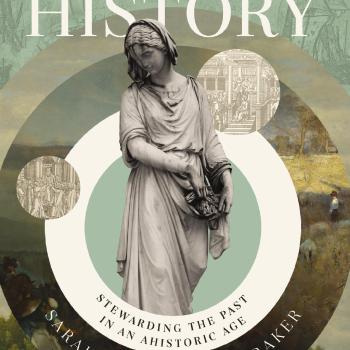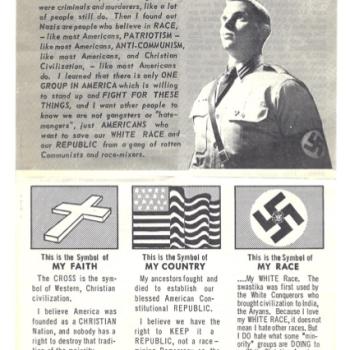15 weeks for the history and present of religion in the United States. “American Religious History” or “Religion in America” is a bread-and-butter course for me (and for several of my co-bloggers, and probably for some readers). I’ve taught it perhaps five or six times, in both a history department and a religious studies department. And I’m never sure exactly what to do.
Where should one begin? I begin very unfashionably, I’m afraid, with John Winthrop’s “A Model of Christian Charity,” largely because I want students to get used to engaging primary sources. Also, by beginning with Winthrop we can then discuss where we should begin. Should we begin with native spirituality? The white-Indian interaction? The diversity of Protestant and Catholic Christianities across North America? Should we begin in Virginia or New England, or with California and Florida?
For understanding the trajectory of religion in the United States, I think it’s of crucial importance for students to have some grasp of Protestantism in its many American manifestations. If there has been a center to American religion, Protestantism is the best candidate. Perhaps evangelical Protestantism in the early-to-mid-nineteenth century, and “mainline” (before the term was coined) Protestantism in the early-to-mid-twentieth century. I very much agree with critics of the “evangelical thesis” such as Jon Butler and Catherine Albanese that too much of a focus on evangelical Protestantism obscures the front-and-center significance of other impulses, such as the state-church/denominational tradition and the role of “metaphysical religion” in its many manifestations. Still, I find it easy to use evangelicalism as a starting point, especially because evangelicals made serious (and ultimately failed) bids for cultural leadership and because so many other American religious movements defined themselves partly in opposition to evangelicalism.
How to help students interact with evangelicalism as it was in the eighteenth century (and how it was quite different in many respects from contemporary evangelicalism)? I like assigning books (perhaps this is also unfashionable), and at this point in the course I’ve often used Jon Sensbach’s Rebecca Revival or Catherine Brekus’s Sarah Osborn’s World. These books serve the double purpose of introducing evangelicalism while also illuminating matters of race and gender. My co-blogger Thomas Kidd’s George Whitefield would be another accessible introduction to transatlantic evangelicalism.
I have used John Fea’s Was America Founded as a Christian Nation? to good effect several times. A number of students have expressed frustration that the book does not provide a simple and straightforward answer to its question, but that’s the point! I’d like to find a concise version of Matthew Stewart’s argument (in his Nature’s God) for a more radical founding to assign as something of a counterpoint.
Once I get past the founding, I find myself pulled in so many directions. I usually at least partly abandon the desire for a chronological narrative at this point and abandon any pretense at comprehensive “coverage.” Instead, I’ve often broken up the remainder of the course into several in-depth units, such as Mormonism, slavery and the development of African American Christianity (I’ve used Albert Raboteau’s Slave Religion several times, which challenges students but always proves its worth), and Catholicism and anti-Catholicism. I am also trying to focus on some aspect of expanding American religious diversity each semester. In a given semester, that might be Latino Christianity, Islam in America, or questions of secularity and unbelief in contemporary America.
I’ve also found myself drawn to other broad thematic overviews, such as those found in David Sehat’s The Myth of American Religious Freedom and Ed Blum and Paul Harvey’s The Color of Christ. Such works allow me to “cover” quite a bit of the terrain while illuminating particular points of controversy. This next semester, I’m going to use Leigh Schmidt’s Restless Souls to further broaden my lens. When I’ve taught the course in the context of religious studies, I do a bit more with foundational questions of how Americans defined religion or Christianity and how such definitions have served to include and exclude certain groups, such as the Latter-day Saints.
Also, in a nod to religious studies, I encourage students to do some comparative work. This spring, I’m going to have students read books on the Nation of Islam (Edward Curtis’s Black Muslim Religion) and Scientology (Lawrence Wright’s Going Clear). Students will compare the two institutions as “new religious movements” and at the same time compare the two authors’ approach to their subjects.
Finally, I try to arrange for students to do something outside of the classroom connected with the readings or in-class discussions. Sometimes, that has involved visits to church or other institutions. Being near Washington, DC., it is also relatively easy to invite community religious leaders into the classroom to help things move beyond the assigned texts.
Every semester, many important subjects are left out. I could “cover” more if I assigned more shorter readings and fewer books, but books allow me to linger with subjects and arguments in a way that shorter pieces cannot. Opportunity costs, one cannot escape them. I supplement the above-mentioned books with
What can one hope to accomplish in fifteen weeks? [I am well aware that Americanists have it relatively easy!] I hope students develop and retain a fascination with some of the course topics, whether that be the evangelical “new birth,” early Mormonism, or enduring American conflicts over the proper relationship between religion and civil society. I try to help them become more skillful readers and writers, doing my best (it’s not good enough) to stamp out the incorrect usage of semi-colons and apostrophes.
Now to the point of this post. Any thoughts, about themes, books, or pedagogy?












